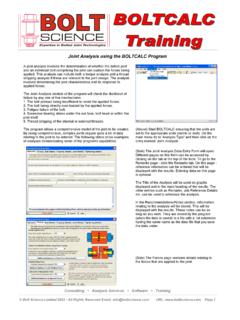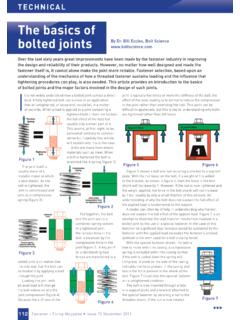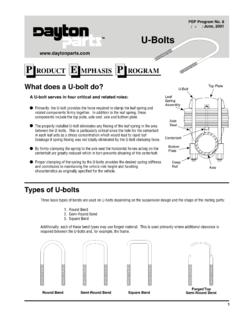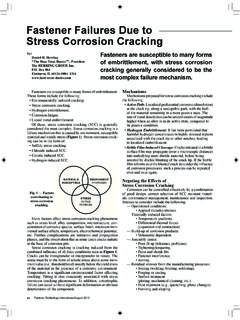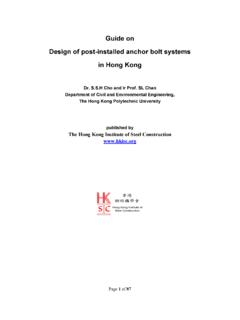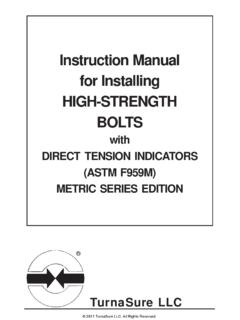Transcription of Article on Fatigue Failure of Bolts - Bolt Science
1 TECHNICAL00 Fatigue Failure of Bolts Within my lifetime, it used to be thought that metal Fatigue wasdue, in some way, to the metallurgical nature of the materialchanging. Somehow the metal got weaker, became tired ( ) and failed prematurely when subjected to alternatingloading. For the last two hundred years it has been a knownproblem and has been the cause of numerous product failuresincluding some involving the loss of life. Nowadays, following agreat deal of research, it is known that Fatigue is due to one ormore cracks progressing through a EcclesBill Eccles is a Chartered Engineer andformed his company bolt Sciencesome 12 years ago to specialise inbolting technology. The companywrites and markets bolted joint analysissoftware together with completingconsultancy assignments and trainingcourses. Further information isavailable from Bill via or from thewebsite at crack can start at some existing defect, such as aninclusion in the metal, or at point of high stress, such as anotch, and slowly grow in length at each loading.
2 It maytake millions of loadings and unloadings (known as load or stresscycles) before the crack is actually detectable. As the length ofthe crack increases, the material remaining is placed underincreasing stress because there is less area to sustain the the crack actually reaches a criticallength it progresses all the waythrough the material resulting incomplete Failure . The term Fatigue damage is frequently used to describe thedamage to a part that has been sustained as a result of Fatigue damage is nowadays equated to crack length. Insome critical applications there is a requirement that Bolts areperiodically crack detected using dye penetrant or even by x-raysto ensure that there are no detectable cracks present. (Cracksmay be present on the microscopic scale, that is, below thedetection threshold of the measurement technique.)The purpose of this Article is to provide some examples ofways in which the design and manufacture of Bolts can affecttheir Fatigue performance.
3 Fatigue Failure of nuts is practicallyunknown since Fatigue cracks propagate as a result of afluctuating tensile stress - nuts are under a compressive stress andso any pre-existing cracks tend not to The quality of the surface finish of the threads is known tohave an effect on Fatigue life: the smoother the surface, thehigher is the Fatigue life. Hence in general terms, threads that arerolled have a higher Fatigue life than a thread that has been Fatigue cracks usually initiate in the roots of the threads, thisis due to this region being highly stressed because of the localchange in section (a so-called stress concentration). Threadrolling AFTER heat treatment induces localised compressivestresses in the thread roots. These compressive stresses help toFatigue is progressive crackingA Fatigue crack can take years to progress through a boltTECHNICAL00 prevent crack initiation and hence improve the Fatigue the threads before heat treatment does not give the samebenefit since the compressive stresses are flushed out with theheat treatment operation.
4 Rolling after heat treatment can offer asignificant improvement. Bolts with threads rolled after heattreatment can have double the Fatigue strength compared withground threads. Although rolling after heat treatment can offersignificant improvements from a design aspect, it is pretty direfrom a manufacturing cost standpoint. The higher hardness of thethreads significantly increases wear on the rolls resulting in alower useful life. Effectively this results in Bolts with threadsrolled after heat treatment being more expensive to produce. (Onlarge diameter threads, inducing compressive stresses in thethread roots to improve Fatigue strength has been achieved byshot peening.)3. Tests have shown that having the nut face too close to thethread run-out region of the thread can result in prematurefailure. The thread run-out region is usually poorly formed and ishence an area of stress concentration.
5 The highest stressed threadis the first one in the nut; having this region in close proximity tothe thread run-out results in a Fatigue strength reduction. Havinga distance of two or more thread pitches from the nut face to thethread run-out eliminates this By increasing the size of the root radius, the stressconcentration is reduced, and the Fatigue strength profiles having a larger root radius than normal (such asMJ threads used for aerospace applications) are used werefatigue resistance is paramount. MJ threads have a minimum rootradius of p (where p is the thread pitch) compared to p for standard metric threads. (Increasing the radius p - the maximum for the MJ profile can result ininterference with the nut thread profile.)5. With Fatigue there is a size effect, the larger the part - thelower is the Fatigue strength, given the same stresses. This appliesto bolt threads and the effect is shown in the Fatigue cracks usually initiate in the thread roots but canalso initiate under the bolt head.
6 Often Failure in this location isthe result of an inadequate under head radius (resulting in a highstress concentration) or the bolt being mounted on an inclinedsurface. A small joint angle (such as two degrees) can have a direeffect on Fatigue strength. This effect has caused many a serviceproblem in the past; a comparatively common problem whenbolting welded structures The load distribution in a nut is not even, the majority of theload is taken by the first few threads. As a result, the majority offatigue failures in fasteners occur in the thread just under the changes that can be made to produce a more even loaddistribution in the nut will improve the Fatigue It has been known for a long time that the use of anasymmetric thread profile can improve the Fatigue life as a resultof it providing a more even load distribution in the nut. The mostcommon asymmetric profile in present use is the Spiralock threadthat is applied to the nut thread and is used with a standard boltthread (thread inserts with the Spiralock profile are available).
7 SPST echnologies also have an asymmetric thread profile that hasbeen quoted to provide a 20% improvement in the bolt On the theme of improving the load distribution in the nutto improve the Fatigue life of the nut, one study reported on aninvestigation to change the nut profile. By placing a groove nearthe face of the nut and making the nut face concaved animprovement in the Fatigue life of 25% was reported. Thisapproach has been used to improve the Fatigue life of very largediameter Bolts . Other approaches to give a more even loaddistribution that have been used are: to use a nut made from amaterial with a different modulus of elasticity to the bolt ; to havea difference in pitch between the bolt and nut threads; and to usea tapered In the vast majority of applications, the most effective wayto ensure that the bolt is Fatigue resistant is to ensure that it istightened sufficiently. A preloaded bolt in a typical joint sustainsusually only around 5% (or less) of the applied loading (theremaining 95% reduces the clamp force acting on the joint).
8 Dueto this, a properly tightened bolt is highly resistant to fatigueloading. (A conn-rod bolt for example would rapidly fail if itwere not tightened.) Because the alternating load is small, so isthe alternating stress, usually well below the bolt 's endurancelimit. Fatigue failures, when they do occur, are frequently theresult of inadequate tightening or loosening that can expose thebolt to bending stresses that it is not designed to sustain.

